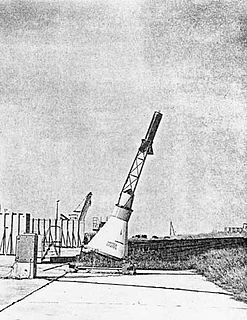
Vega, is an expendable launch system in use by Arianespace jointly developed by the Italian Space Agency and the European Space Agency. Development began in 1998 and the first launch took place from the Guiana Space Centre on 13 February 2012.

The Falcon 1 was an expendable launch system privately developed and manufactured by SpaceX during 2006–2009. On 28 September 2008, Falcon 1 became the first privately-developed liquid-fuel launch vehicle to go into orbit around the Earth.
Kosmos 133, was the first unmanned test flight of the Soyuz spacecraft, and first mission of the Soyuz programme, as part of the Soviet space programme.

A launch escape system (LES) or launch abort system (LAS) is a crew safety system connected to a space capsule, used to quickly separate the capsule from its launch vehicle rocket in case of a launch abort emergency, such as an impending explosion. Such systems are usually of two types:

The Soyuz-U launch vehicle was an improved version of the original Soyuz rocket. Soyuz-U was part of the R-7 family of rockets based on the R-7 Semyorka missile. Members of this rocket family were designed by the TsSKB design bureau and constructed at the Progress Factory in Samara, Russia. The first Soyuz-U flight took place on 18 May 1973, carrying as its payload Kosmos 559, a Zenit military surveillance satellite. The final flight of a Soyuz-U rocket took place on February 22, 2017, carrying Progress MS-05 to the International Space Station.

The Soyuz-FG launch vehicle is an improved version of the Soyuz-U from the R-7 family of rockets, designed and constructed by TsSKB-Progress in Samara, Russia. It made its maiden flight on 20 May 2001, carrying a Progress cargo spacecraft to the International Space Station (ISS).

A pad abort test is a test of a launch escape system to determine how well the system could get the crew of a spacecraft to safety in an emergency on the launch pad.

The year 2010 in spaceflight saw a number of notable events in worldwide spaceflight activities. These included the first test flight of the SpaceX Dragon commercial resupply spacecraft, which is intended to resupply the International Space Station (ISS), and the maiden flights of the Falcon 9 and Minotaur IV rockets. In June 2010, South Korea conducted a second Naro-1 launch, after the failure of the rocket's maiden flight in 2009; however, the second attempt also failed. The Kosmos-3M was retired from service, making its final flight in April. The Molniya-M was also retired from service, making its final flight in September.

Minotaur IV, also known as Peacekeeper SLV and OSP-2 PK is an active expendable launch system derived from the LGM-118 Peacekeeper ICBM. It is operated by Northrop Grumman Innovation Systems, and made its maiden flight on 22 April 2010, carrying the HTV-2a Hypersonic Test Vehicle. The first orbital launch occurred on 26 September 2010 with the SBSS satellite for the United States Air Force.

Ratsat, or DemoSat, was a 165-kilogram (363-pound) non-functional boilerplate spacecraft used as a mass simulator on the fourth flight of the Falcon 1 rocket, launched 28 September 2008.

The Soyuz-2-1v, GRAU index 14A15, known earlier in development as the Soyuz-1, is a Russian expendable carrier rocket. It was derived from the Soyuz-2.1b, and is a member of the R-7 family of rockets. It is built by TsSKB Progress, at Samara in the Russian Federation. Launches are conducted from existing facilities at the Plesetsk Cosmodrome in Northwest Russia, with pads also available at the Baikonur Cosmodrome in Kazakhstan, and new facilities at the Vostochny Cosmodrome in Eastern Russia.

Several new rockets and spaceports began operations in 2016. Russia inaugurated the far-Eastern Vostochny Cosmodrome on 28 April 2016 with a traditional Soyuz-2.1a flight, before expanding it for the Angara rocket family in the following years. The Chinese Long March 7 flew its maiden flight from the new Wenchang Satellite Launch Center on Hainan Island on 25 June, and the maiden flight of the Long March 5 took place on 3 November. Two years after its 2014 accident, the Antares rocket returned to flight on 17 October with its upgraded 230 version featuring the Russian RD-181 engine.

Notable spaceflight activities in 2017 included the maiden flight of India's Geosynchronous Satellite Launch Vehicle Mark III on 5 June and the first suborbital test of Rocket Lab's Electron rocket, inaugurating the Mahia spaceport in New Zealand. The rocket is named for its innovative Rutherford engine which feeds propellants via battery-powered electric motors instead of the usual gas generator and turbopumps.

This article lists achieved spaceflight events in 2018. For the first time since 1990, more than 100 orbital launches were performed globally.

Antares A-ONE was the maiden flight of Orbital Sciences' Antares rocket with a boilerplate payload, the Cygnus Mass Simulator, which was launched 21 April 2013. It was launched from Pad 0A at the Mid-Atlantic Regional Spaceport (MARS) on Wallops Island, Virginia, USA. The boilerplate payload simulates the mass of the Cygnus cargo spacecraft. This dummy payload was sent into an orbit of "approximately 150 by 160 miles" with an inclination of 51.6 degrees.
Aist 1 is a Russian technology demonstration satellite which was launched in December 2013. Aist 1 is operated by the Samara Aerospace University, who constructed it in partnership with TsSKB Progress. It is the second launched Aist satellite, following Aist 2's April 2013 launch.

Progress MS-01, identified by NASA as Progress 62 or 62P is a Progress spacecraft used by Roskosmos to resupply the International Space Station (ISS) during 2015. It was launched on December 21, 2015, to deliver cargo to the ISS. Progress MS-1 is the first vehicle in the Progress-MS series.

















